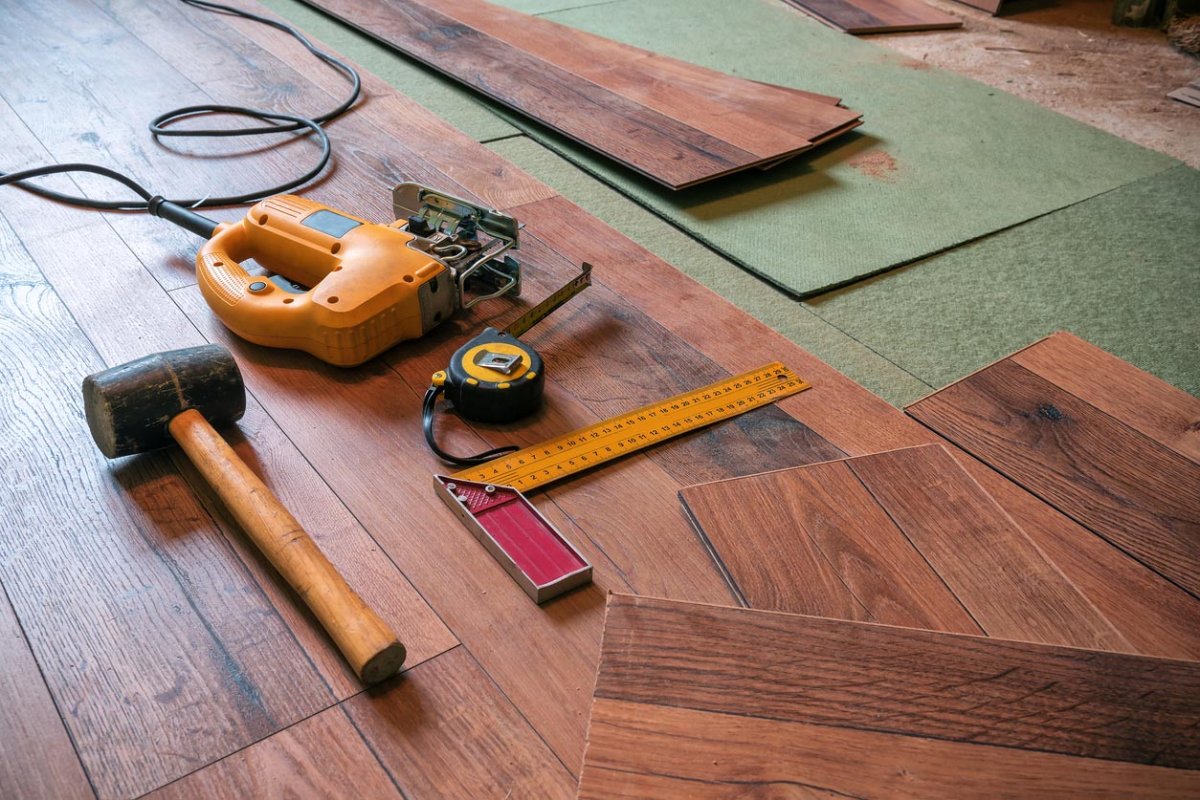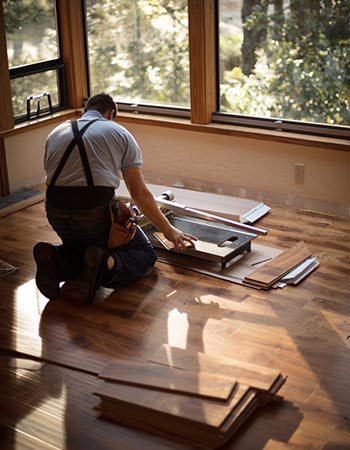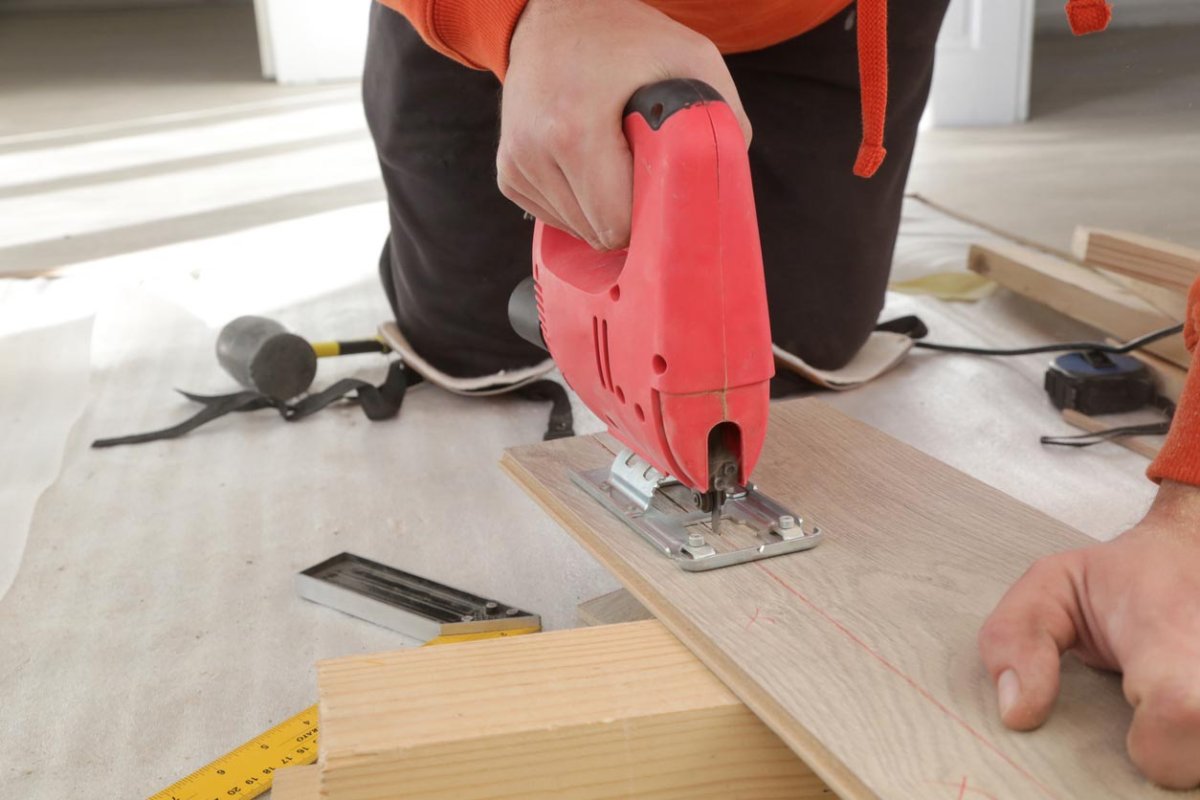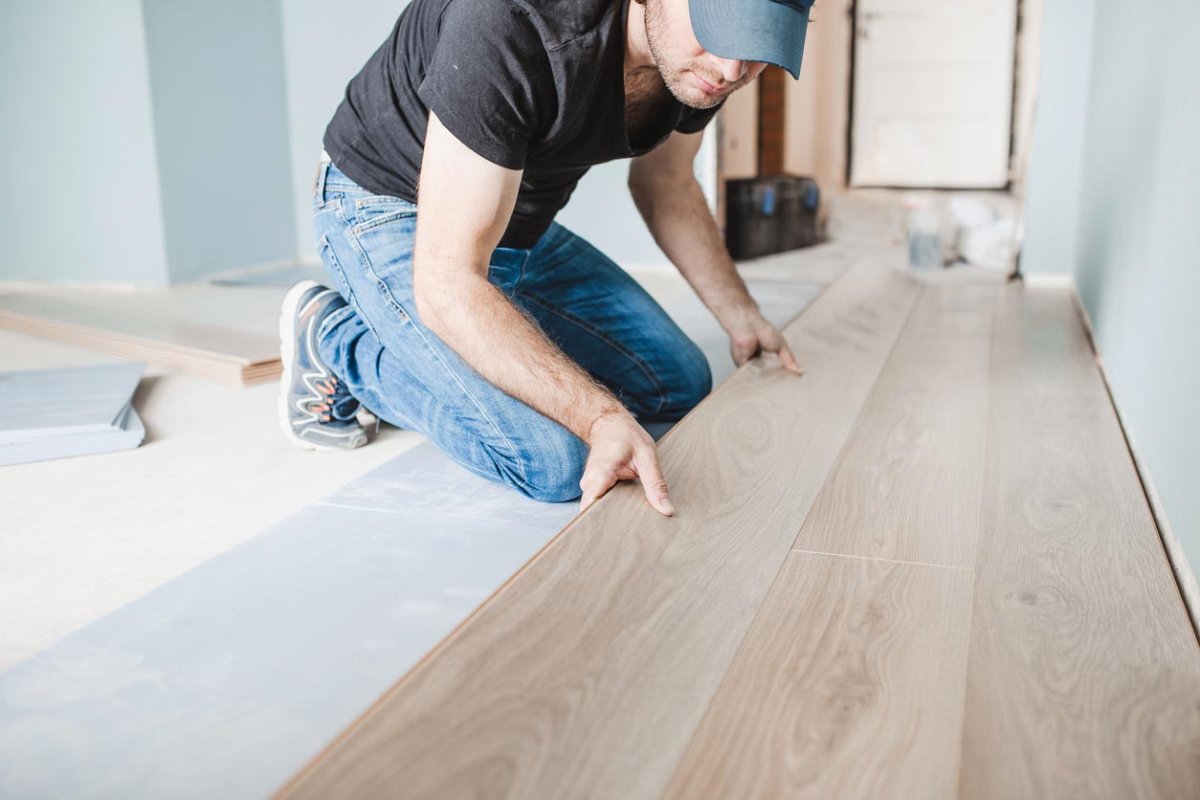

We may earn revenue from the products available on this page and participate in affiliate programs. Learn More ›
What You Need to Know
- Before starting a flooring project, it’s important to know the most common pitfalls that can cost you more time and money. These include choosing the wrong flooring material, settling for low-quality material, renovating in the wrong order, underestimating the project timeline and cost, attempting to DIY without the correct skills, and choosing the wrong contractor.
- The key to a successful flooring installation is knowledge. Savvy homeowners can gather information from a contractor’s past clients and online reviews in addition to educating themselves on the right questions to ask before hiring a contractor
- In addition to doing research, consulting multiple contractors is a great way for homeowners to avoid scams and weed out contractors who aren’t well suited to the job.
- Choosing a reputable installer (like Empire Today) can help safeguard against common mistakes and allow for peace of mind—as well as a top-notch job and beautiful floors.

Carpet, hardwood, vinyl, and tile flooring.
Bob Vila has partnered with Empire Today to help you easily get beautiful new floors at a great price. Free In-Home EstimatesA new floor can update a home, bring a whole new look and feel to a space, and increase sound and heat insulation, among providing other benefits. But it’s a big project to take on, and when faced with the wealth of choices and options, many homeowners can feel overwhelmed. Unfortunately, mistakes are often made in the planning and execution of a flooring project, and those mistakes can be costly both in terms of money and time. Knowing the biggest and most common mistakes homeowners make when redoing their floors can help you avoid them in your own project.
7 Mistakes That Can Derail Your Flooring Remodel Project

Being aware of common mistakes that can occur when you’re planning for a flooring update can help you avoid additional costs and keep the project on a predicted timeline.
1. Choosing a flooring material that isn’t right for the space.
Lifestyle, taste, preferences, and needs are key considerations when homeowners are choosing flooring for each space. However, many pros would agree that some flooring types are just not suitable for certain areas or rooms.
For example, carpet generally does not belong in bathrooms, kitchens, or in basements that are particularly damp. Carpet can stain easily, and frequent cleaning can leave it perpetually damp. It then becomes a haven for mold, mildew, and bacteria.
For similar reasons, hardwood isn’t ideal for bathrooms, mudrooms, and other areas of the home that tend to get wet. Some engineered wood flooring may be rated for moist areas, but genuine hardwood can’t withstand prolonged moisture and risks bubbling, swelling, popping, and peeling.
Softer flooring such as laminate or vinyl plank can be a mistake in high-traffic areas, as it can scratch, dent, or warp and crack. And if the wrong kind of tile is installed for a flooring project, it can crack or break when it’s walked on.
Ultimately, the choice of flooring needs to be suited to the room’s purpose. If it’s not, homeowners may find themselves having to replace the flooring more often or spending time and money making repairs for issues that could have been avoided by choosing the correct flooring in the first place.
When considering your options, it’s key to balance durability, design, and your personal preferences, as well as the maintenance that will be required. Choosing a floor that will hold up to the daily activities that take place in the room can mean less headache in the long run. And a qualified flooring expert can help you understand what the best choice for each space will be.
2. Settling for low-quality materials to cut down on costs.
Flooring projects are undoubtedly expensive, making it tempting to choose the least expensive materials to cut down on costs. Unfortunately, low cost often means low quality. This means that the flooring may not stand up to daily use and will wear out faster, and therefore may need repair and replacement much sooner than anticipated. While the up-front cost may be lower, the long-term cost may end up being higher than if you’d selected a higher-grade material at the outset.
This doesn’t mean that the only worthwhile options are luxury-grade flooring materials; it’s not necessary to purchase the most costly option. But choosing a material that is a recommended mid-range option with higher-quality construction will likely result in a floor that has a better appearance long term and a longer lifespan. Choosing low-cost flooring can mean homeowners waste time and money on repairs and premature replacements in the future.
To avoid this pitfall, spend some time researching the materials you like. Look for information that can help you make the best decision, including each material’s lifespan and features as well as complaints made by those who have purchased those materials. Most importantly, talk to a flooring expert who can guide you. Although some shoppers might worry about being upsold, most reputable installers would prefer to make their customers happy with a job well done rather than make some extra cash on a single project. Since happy customers tend to spread the word to other potential customers about satisfactory services, reputable installers are likely to take care of their customers to avoid the risk of getting a bad review.
3. Renovating in the wrong order.
If you’re tackling a remodel or a larger renovation and the flooring isn’t the only change you’re making, it’s important to consider the order in which you complete each task.
More specifically, tackling flooring after your walls have been freshly painted can spell trouble. Replacing old flooring almost always comes first; there’s no sense in risking damage and ruining a brand-new paint job in the process of tearing out old floors.
Many homeowners choose to remove old flooring, paint their walls, and then install new flooring since this would theoretically help avoid getting paint splatters on the new floors. However, installing new flooring requires the removal of trim and baseboards. Sometimes new edging or tack strips need to be installed. And after that, the trim and baseboards need to be reinstalled. All of that work is just as likely to damage walls.
The best plan for a clean finish that protects your new investment is to remove the old flooring first, then install the new flooring and trim. After carefully and thoroughly masking the new floor with protective heavy paper or overlapping drop cloths, then you can tackle the walls.
4. Underestimating the project timeline.
One of the biggest mistakes homeowners make when taking on any remodeling project is rushing the timeline.
A flooring project happens in phases, with the first being the removal of old flooring. Some additional time may be needed to address underlying issues. Perhaps the subfloor needs to be repaired or replaced or there are areas behind the existing trim that need to be patched.
Installing the new flooring is the next phase. The time this takes to complete will depend on the square footage of the area, the type of flooring being installed (which will determine the type of underlayment and prep that is necessary), and the intricacy of the work (seaming, pattern matching, and seam staggering, for instance).
Depending on the type of flooring that’s being installed, the material may need time to settle for a few days before the room can be used again. Flooring is stored in warehouses in boxes of planks or rolls of carpet or sheet vinyl. A warehouse may have higher or lower humidity than a climate-controlled home, depending on the season. If the installer does the job without letting the flooring acclimate to the humidity in the home, the flooring could shrink or warp or expand after the installation is complete, resulting in gapping, buckling, or warping. In short, the new floors risk being damaged if they’re put in use too soon after the installation.
Material aside, rushing the timeline of a flooring project puts pressure on contractors to cut corners with installation. Speeding up work also means that mistakes are more likely to be made. Correcting these mistakes can be costly and can extend the project timeline even longer.
ou can avoid the mistake of underestimating the flooring project’s timeline by working with your installer to ensure each phase of the project is well defined. If you purchase your materials during the best time to buy the flooring, choose one of the best flooring companies to work with, and know the signs of a flooring scan. you’ll be able to get an accurate timeline that meets your expectations. This will also allow you to be aware of and prepared for potential delays in your project
A reputable installer can help you manage your expectations. It’s better to overestimate the timeline and be pleasantly surprised that the furniture can be moved back in a few days ahead of schedule than it is to underestimate the timeline and invite heavy foot traffic into a room that isn’t prepared for it.

5. Underestimating the project budget.
Budget is an unavoidable part of any home improvement project. When you’re replacing flooring, it’s important to consider not only the flooring itself but also potential issues that may be uncovered during the installation. Not considering these factors can lead to a homeowner grossly underestimating the true cost of the project in terms of both time and money.
Floors can cover up issues that may be brewing underneath the surface, and these problems range in size and nature. Pest infestation, cracked joists, dry rot, mold, asbestos, and damaged subfloors are just a few of the types of issues that can be unveiled when a contractor starts peeling back layers of flooring.
Therefore, it’s advised that the budget include contingencies for unexpected situations. While it’s not considered necessary to have funds set aside for everything that can unexpectedly go wrong, it’s best to build a budget with the total cost of the flooring plus some wiggle room.
Working with a reputable contractor can help you decide how much of your budget should be dedicated to that wiggle room. Flooring installers have the experience to evaluate the current state of a home’s flooring. They can anticipate which issues are likely to arise (if any) and balance their observations with customer vision, the labor required, and the materials necessary. This can help limit any unexpected expenses and additional time needed to complete a flooring project.
To make sure your budget is realistic, consider taking the following measures.
- Work with a company that provides in-home consultations. You’ll be able to see flooring samples in the natural light of the home and see how the flooring will work in the space. The consultant can also evaluate your current floors and see if there are any obvious issues that would need to be addressed before new flooring is installed. Then, they can provide a more accurate estimate.
- Gather quotes and estimates from several contractors. To get the most accurate estimate for how much you’ll spend, it’s best to check with more than one contractor. There’s always a chance of human error, and each contractor works a little differently. For this reason, having several different estimates can help you identify where there are large discrepancies in quotes so you can ask clarifying questions and budget accordingly. Everything from how much flooring is needed to even whether or not it’s time for a floor to be replaced can be boiled down to a matter of opinion.
- Request a written and itemized estimate. Some companies provide an all-inclusive estimate that covers all phases of the project, from old floor removal and furniture moving to cleanup and material hauling. But to get a good idea of where your money is going, ask for an itemized estimate. You may want to ask questions about each item—and perhaps even negotiate costs.
- Plan for the unexpected. It’s safest to carve out a part of your budget for unexpected repairs. A contractor can help you decide how much. Ultimately, you want to be sure that you’ll have enough money to tackle the project from start to finish without putting a strain on your wallet. You don’t want to get stuck with a half-finished project or a subpar job.
Careful consultation, planning, and organization can help you set a realistic budget. Then, you’ll be in a position to choose a product to install that is the nicest you can reasonably afford.
6. Attempting DIY flooring installation without the necessary experience or equipment.
Many homeowners may be tempted to DIY flooring projects because of how straightforward they can seem on television. However, the truth is that tackling a flooring remodel from start to finish is a job meant for those with the required skills (and confidence) to ensure that the project will be completed satisfactorily and safely.
This is not to suggest that flooring can’t be a DIY project. Handy homeowners with a fair amount of know-how and the right tools can do a great job installing some types of flooring, especially flooring that is designed to be installed by nonprofessionals.
However, in most cases, there is a lot of risk involved with attempting to DIY flooring installation without the proper experience or equipment.
Flooring material can be quite expensive. Not only is there a risk of ordering the wrong amount of material for the project, but an ill-prepared homeowner can just as easily damage materials by making the wrong cuts, or making other mistakes in manipulating the material. By the end of the project, a homeowner may have inadvertently caused more damage to their flooring such that the intervention of a pro is needed for repair—or worse, total replacement.
If you’re inclined to try a DIY installation, it’s important to make sure that you are prepared for what lies ahead: It’s a labor-intensive job. The costs can easily mount with each mistake made.
For peace of mind, it’s worth hiring a reputable contractor who knows the job best. And if you want to take part in the project without taking on the risks, there are phases that can be DIYed. For instance, moving furniture, ripping out old flooring, and removing junk are projects that are safe for those with less skills and experience to take on.

7. Choosing the wrong flooring contractor.
Your chosen contractor can make or break a flooring project. An honest, transparent, skilled, and knowledgeable contractor can help make the project run smoothly from start to finish. But a contractor who isn’t the right fit can be a big liability and can cost you time and money.
Some installers will estimate their project costs so that they’ll come in less than their competitors. While this doesn’t always mean that the contractor is attempting to scam a potential customer, cheaper services can mean a contractor with less experience and skills who is using lower-quality materials. This can mean that your new floors won’t last as long as they should, or they’ll need repairs soon after installation because the installation itself was less than ideal. With floors being such an investment of time and money already, it’s not worth the risk to choose the “cheapest” contractor.
Choosing a contractor who has little or no experience with your material of choice is not recommended. For example, a contractor may have rave reviews for installing hardwood and gorgeous photos of their work. But if hardwood is their specialty and you’re looking to hire them to install tile, you may want to consider a different professional. This is because they may not have the experience necessary to perform the job competently.
Falling for a flooring contractor who is attempting to scam you is another issue. There are signs of flooring scams to look for, including inconsistencies with room measurements and flooring samples, deals that sound too good to be true, disappearing deposits, mounting costs, and false claims about products.
The best way to avoid these scammers is to thoroughly research local contractors by reading reviews, asking for references, and checking sites such as the Better Business Bureau and online social networks.
Jim Olenbush, a broker and the founder of AustinRealEstate.com, also warns about potential scammers, saying, “Red flags include avoiding questions, pressuring decisions, or using contracts with ambiguous terms. Reputable businesses respect clients and stand confidently behind their work.”
It’s worth taking the time—and it may be more time than you expect—to really vet potential contractors before hiring one. This ensures that the one you choose is the best fit for your job, and the time you spend is well worth it in the end.

Carpet, hardwood, vinyl, and tile flooring.
Bob Vila has partnered with Empire Today to help you easily get beautiful new floors at a great price. Free In-Home Estimates3 Ways to Practically Guarantee a Successful Flooring Remodel
Knowing the biggest mistakes that can make a floor remodeling project a headache can help you avoid them. But also knowing the ways you can make the experience a positive one can all but guarantee success as well as save you time and money. Investing time in research before starting a project is key,
Researching factors like materials, costs, and timelines before scheduling the remodel.
It’s important to get a really good idea of all the material options available to you, how much each one costs, the additional costs associated with the project, and how long each phase of the project will take to complete.
This research phase can have a multipronged approach. It’s worth asking people who have completed projects similar to yours about their experience and what they wish they had done differently. It can mean browsing online for general information about your project as well as tips and tricks from professionals themselves. It also usually means using online cost calculators and estimators as well as making phone and email inquiries about guarantees and warranties.
Before you bring on a professional, it’s best to have a good idea of the look you’re seeking, a list of questions, and a ballpark idea of the cost and time frame. After you have these details ironed out, you can spend some time researching flooring companies and contractors to narrow down the list of those you might choose to work with and seek estimates from. Friends, neighbors, online reviews, and the Better Business Bureau are all good sources of information.
Ultimately, you’ll want to arm yourself with knowledge so by the time you’re interviewing contractors, you know what questions to ask and will be able to identify any red flags. With research, you’re setting yourself up for a successful project.
Starting the project with a consultation from a flooring professional.
The next step is to contact and schedule a consultation with one (or more) of the companies you identified as reliable choices. Some companies, such as Empire Today, require a consultation as the first step: they don’t provide estimates over the phone. While this may feel like an inconvenience, it actually serves an important purpose. In-home consultations with professionals can help customers avoid falling victim to scams. They’ll be able to observe the consultant measuring the home, and they’ll be able to see how the flooring materials look in their homes alongside their furniture and home decor instead of in a showroom.
In addition, an in-home consultation gives you an opportunity to do a gut check on how you feel about the company’s representative. While the consultant’s goal is to sell you flooring, you can decide how the representative presents the company’s ethic. This in turn can empower you to choose a company you’re comfortable working with.
You’ll often receive a same-day estimate on the project. Empire Today offers an all-inclusive estimate that includes every cost the project will incur (barring any surprises). Some companies provide carefully itemized estimates at this point, and others may take a day or two to check pricing or availability and will get back to you. If a consultant can’t provide a timely estimate, or if they simply offer a number with no indication of what is included in that number, schedule another consultation with a contractor or company that can.
- Read the BobVila.com Empire Today review.
Choosing a reputable flooring company to supply and install the flooring.
Once you’ve collected and compared estimates, services, reviews, timelines, and material offerings of different flooring companies, it’s time to choose the right installer for your project. There are several ways to make sure that a flooring company is reputable. These include verifying that the professionals you’re working with have the right experience, skills, transparent billing practices, and honest communication.
Selecting a reputable flooring company makes it much more likely that you’ll have a successful project. Empire Today is an example of one such trusted flooring company. The company holds its employees to a high standard, and as a result offers top-notch services and high-quality products. Empire Today also has free online tools such as in-home visualizers and written resources to help customers make the best decision for themselves and their homes. Whether a customer selects a brand with a national presence like Empire Today or chooses to go with a local contractor, the secret to a successful flooring project is a homeowner who is informed and knowledgeable.

